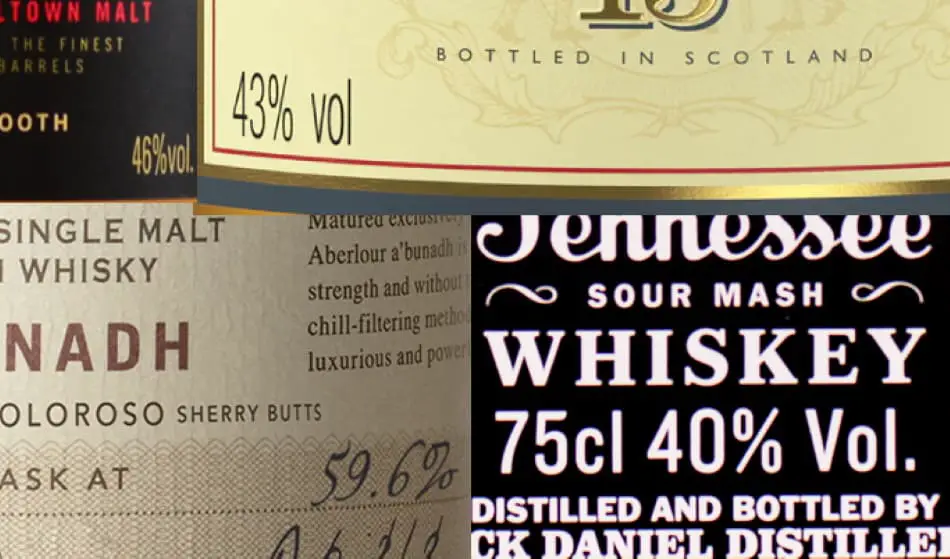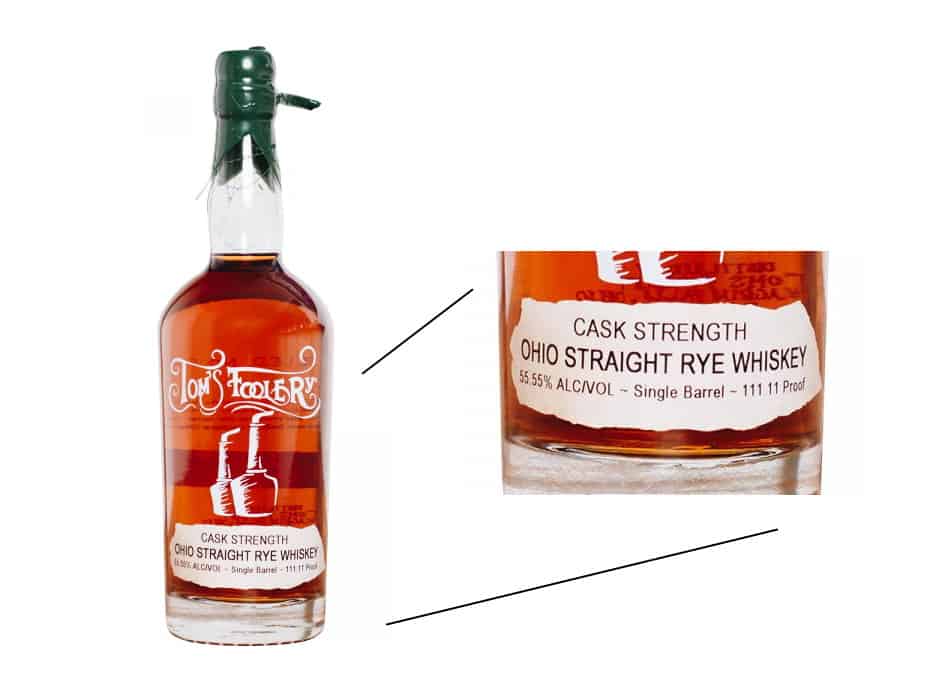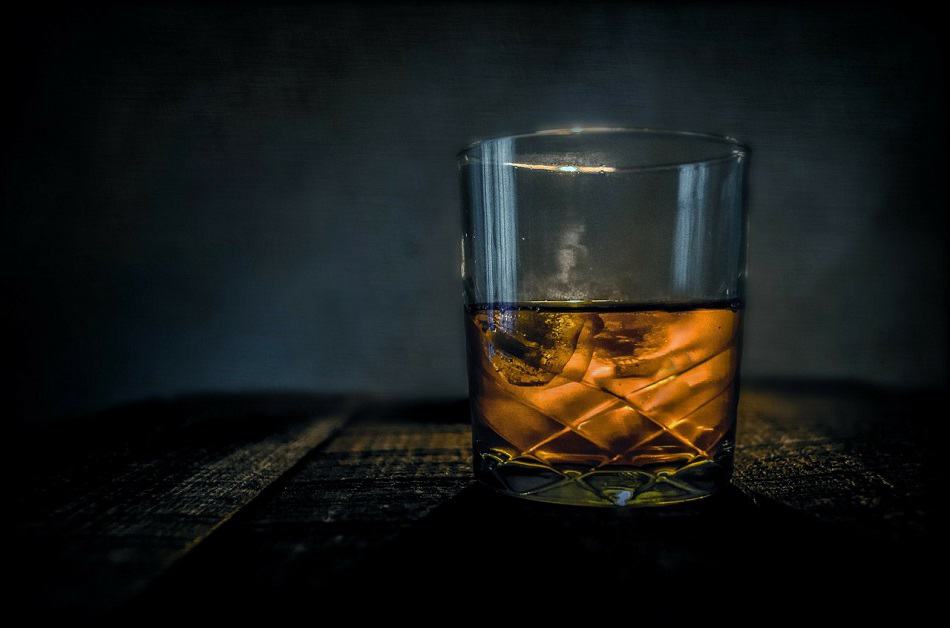Whiskey is known for having a high level of alcohol despite being diluted from its original distillation strength that for Scotch can be up to 94.8%ABV! I wanted to find out more about the alcohol content of whiskey, so I looked at the ABVs of about 3000 of the most popular whiskeys and here’s what I found.
The alcohol content of whiskey ranges from 40% – 68%ABV. Cask strength whiskey ranges from 52% – 68%ABV. While you can find a whiskey at almost any ABV percentage within this range, the most common alcohol strengths for whiskey are 40%, 43% and 46% for reasons to do with price, flavor and a whiskey’s color.
The rest of this article will look at how the most common whiskey ABVs vary by country, region and type of whiskey, which is very useful because if you prefer a stronger or weaker whiskey you’ll know where to look. We’ll also explain why the ABVs of 40%, 43% and 46% are so common, and compare the alcohol content of whiskey to that of other alcoholic drinks.

The Amount of Alcohol in Whiskey by Country, Region and Type
The following table shows the common ABV percentages of non-cask strength whiskeys (40% – 52%) by country, region and type.
When reading the table, please bear the following in mind:
- All the data is taken from the 3000 (approximately) whiskies that I looked at.
- All the ABVs listed in each row, together make approximately three quarters of the ABVs for that type of whiskey.
- The ABVs are listed in descending order of how common they are, so those that are earlier in the list are more common than those after them.
- ABVs that are bolded are significantly more common than those of the same type that are not bolded.
- A range means a lot of different ABV percentages but no common ones (in that range). They are listed last for that reason but the number of whiskeys in the range could be more than the number of whiskeys in the common ABVs listed earlier.
| Common ABVs | |
|---|---|
| American Whiskey | |
| Bourbon | 45%, 40%, 50% (43%, 47%, 46%) |
| Malt Whiskey | 46%, 50%, 43% (47%, 40%, 45%) |
| Blended Whiskey | 40%, 43% |
| Rye Whiskey | 50%, 45%, 46% (43%, 40%) |
| Scotch Whisky | |
| Highland Single Malt | 46%, 43%, 40% |
| Lowland Single Malt | 46%, 43%, 40% (47% – 52%) |
| Campbeltown Single Malt | 46% (47% – 52%) |
| Speyside Single Malt | 40%, 43%, 46% |
| Islay Single Malt | 43%, 40%, 50%, 46%, 48% |
| Island Single Malt | 40%, 45.8%, 46% (47% – 52%) |
| Blended Malt | 46%, 40%, 43% |
| Grain Whisky | Large number of different ABVs |
| Blended Whisky | 40% |
| Irish Whiskey | |
| Single Malt | 46%, 40%, 43%, 50% |
| Single Pot Still | 46%, 43%, 40% |
| Blended Whiskey | 40%, 43%, 46% |
| Japanese Whisky | |
| Single Malt | 48%, 43%, 46% (50%, 40%, 45%) |
| Blended Malt | 43%, 46%, 40%, 48% |
| Blended Whisky | 43%, 40% |
| Canadian Whisky | 40%, 43% |
| 12-Year-Old Whiskey | 40%, 46%, 43% |
| 15-Year-Old Whiskey | 43%, 46%, 40% |
| 18-Year-Old Whiskey | 43%, 46%, 40% (47% – 52%) |
| 21-Year-Old Whiskey | 43%, 46%, 40% (47% – 52%) |
| 25-Year-Old Whiskey | 43%, 46% (47% – 52%) |
Now you can see why I mentioned earlier that the most common ABVs are 40%, 43% and 46%. They are the most common ABVs in all five of the major whiskey producing countries, in all the Scotch whisky regions and in all types of whiskey. American whiskeys have two additional common ABVs, 45% and 50% and Japanese whiskies have one additional common ABV, 48%.
The common ABVs of American whiskeys tend to be higher than those of other countries with American Rye whiskeys having the highest alcohol content. If you want a stronger whiskey that’s not quite cask strength, look for an American whiskey with 50%ABV.
When it comes to Single Malt Scotches, their highest common ABV (from Highland, Lowland and Campbeltown) only reaches 46%. (I say ‘only’ but that’s relative to American whiskeys. By itself a whiskey with an alcohol content of 46% is still very strong.) The only exception to this is with Single Malts from Islay where you do see a common ABV of 50%.
Speyside Single Malts tend to have a lower ABV with most being 40% and 43%. If you want a Single Malt Scotch and don’t like your whiskey quite so strong, you’ll find plenty among those made in this region.
About three quarters of the non-cask strength whiskeys that I looked at were one of the 3 – 6 common ABVs listed for their type, but for Lowland, Campbeltown and Island Single Malts that number was far less as there were also a lot of different ABVs between 47% – 52%. In fact, most Lowland Single Malts fell into that range and while 40%, 43% & 46% were still the most common ABVs, they were far less common than usual.
Irish whiskey is very similar to Scotch – alcohol content wise, as is Japanese whisky, although it does have an additional common ABV of 48%. If you want something stronger than the 46%ABV that is so common in Scotches but not as strong as the high of 50%ABV found in American whiskeys, then it will be useful to know that the most common ABV for Japanese Single Malts is 48%.
Two whiskey types stand out as having a lower alcohol content than all the others. Canadian whiskies are mostly 40%ABV as are blended whiskeys.
I also thought it would be interesting to see if there were any differences in alcohol content by age. As the table shows, 12-year-old whiskeys tend to have a lower ABV, 15-year-old whiskeys a more equal spread and 18-year-old whiskeys a higher ABV. 21- and 25-year-old whiskeys tend to have a lot of different ABV percentages at the high end of the non-cask strength ABV spectrum.
The Amount of Alcohol in Cask Strength Whiskey
When it comes to cask strength whiskeys (52% – 68%ABV) there are no common ABVs. The reason for this is that there are fewer (relatively – no need to panic) whiskeys being made at higher ABVs. The exception to this is American Rye whiskey and Single Malts from Lowland and Campbeltown, but because they make whiskeys at so many different alcohol percentages in this slightly larger range, there will still be no common ABVs.
The following table shows the ABV range of most cask strength whiskeys by country, region and type.
| ABV Range | |
|---|---|
| American Whiskey | 55% – 60% |
| Scotch Whisky | |
| Highland Single Malt | 55% – 60% |
| Lowland Single Malt | 55% – 63% |
| Campbeltown Single Malt | 52% – 60% |
| Speyside Single Malt | 55% – 60% |
| Islay Single Malt | 55% – 60% |
| Island Single Malt | 55% – 60% |
| Blended Malt | 55% – 60% |
| Irish Whiskey | |
| Single Pot Still | 55% – 60% |
| Blended Whiskey | 52% – 55% |
| Japanese Whisky | 55% – 60% |
| Canadian Whisky | Few Cask Strength Whiskies |
As you can see most cask strength whiskeys fall into the 55% – 60%ABV range and there is little difference between countries with the exception of Canada that has very few whiskies at cask strength. This is in line with the fact that most of their non-cask strength whiskies also have a lower alcohol content.
Within Single Malt Scotches, those from Lowland fall into a wider range of ABVs that includes more whiskies up to 63%ABV, and those from Campbeltown fall into a wider range of ABVs that includes more whiskies from 52%ABV. Now you know where to look for more of the strongest and weakest cask strength whiskies.
And for those who like interesting / weird things, the most unusual ABV I discovered was in this range. Tom’s Foolery distillery makes a Cask strength Straight Rye whiskey at a fantastically repetitive 55.55%ABV!

Why the Common ABVs of Whiskey Are 40%, 43% & 46%
It’s no coincidence that the most common ABVs of whiskey are 40%, 43% and 46%. There are sensible reasons why the alcohol content of whiskey is so often one of these three percentages, and they are to do with price, flavor and a whiskey’s color.
The reason why many whiskeys have an alcohol content of 40% is because, in most countries, that’s the legal minimum bottling ABV for whiskey. This is not because there’s an intrinsic need for whiskey to have at least this amount of alcohol, but purely because of historical factors.
During the First World War, the UK passed legislation to curb liquor consumption. By 1917 the alcohol level of Scotch Whisky could be no less than 28.6% and no more than 40%. While this restriction was lifted after the war, in 1920 the duty on whisky was raised and the distillers were banned from adding this tax to the whisky’s price. This meant that making whisky above 40%ABV became cost prohibitive for many years.
With everyone accustomed to 40%ABV whisky, that became its minimum alcohol level in the 1988 Scotch Whisky Act.
In the United States during the era of prohibition, bootleggers added more water to whiskey to stretch their supplies and after prohibition stronger whiskeys were still in short supply. In the 1960s vodka and light rum became very popular and major whiskey brands wanted to take advantage of this low alcohol content trend. They started making whiskies at 40% and 43%ABV which also became popular (presumably the lower alcohol content made whiskey more accessible to more people) and they became a staple of the industry.
The reason why a lot of whiskeys have an alcohol content of 43% is to do with the balance between flavor and cost.
Flavor is what whiskey is all about and the amount of alcohol in a whiskey has a huge impact on its flavor.
Alcohol carries flavor compounds, but this doesn’t mean that whiskeys with a higher ABV will have more flavor while those with a lower ABV will have less flavor. It means that whiskeys with a higher alcohol content will have a more intense and concentrated flavor. Richer flavors come out at a higher ABV, and lighter flavors come out at a lower ABV.
This is why a lot of people like higher strength and cask strength whiskeys but unfortunately so does the government that collects taxes on alcohol. The higher the alcohol content, the higher the tax and the higher the price.
You may like the type of flavors associated with a whiskey that has a higher alcohol content, but you probably won’t like the extra tax that’s associated with it too. A 43%ABV whiskey is probably the highest you can go to get those flavors before the increase in price due to alcohol tax becomes too much for many people.
The reason why a lot of whiskeys have an alcohol content of 46% is because it removes the need for whiskey to go through a process called chill filtration.
Whiskey contains fatty acids, esters and proteins that dissolve in alcohol but not in water. When the alcohol concentration becomes low enough or the whiskey cold enough (lower than room temperature) these molecules un-dissolve, clump together and make your whiskey cloudy.
This is a problem for distilleries because many people add water to their whiskey to dilute it or ice to cool it, so the chance of a cloudy whiskey is high and while this doesn’t mean the whiskey has gone bad, with a hazy non-golden colored whiskey in their hand, people may think it had.

To prevent whiskey clouding (or to be more precise to prevent the negative consequences of whiskey clouding – complaints and loss of sales) distilleries put many of their whiskies through a process called chill filtration. The whiskey is chilled so that the fatty acids, esters and proteins un-dissolve, and then passed through a series of filters which remove the clumps that form the cloudy haze.
The only problem is that according to some people, these fatty acids, esters and proteins contain a lot of flavors, so while chill filtering prevents whiskey clouding it also removes some of its flavor too!
So, distillers started to make whiskey at 46%ABV, because at that level of alcohol the fatty acids, esters and proteins will remain dissolved even if cooled. The whiskey won’t go cloudy so there’s no need to chill filter it and it will therefore keep all its flavorful compounds.
This does make the whiskey more expensive but it’s a balancing act between price, flavor and color.
If you want as much flavor as possible and the best color, you’ll have to compromise on the price and get a whiskey with at least 46%ABV. If you want as much flavor as possible and a not too expensive price, you’ll have to compromise on the color and get a non-chill filtered whiskey at 40% or 43%ABV. If you want the best price and the best color, you’ll have to compromise on flavor and get a chill filtered whiskey at 40%ABV.
Either way, to find a whiskey from 40% – 50%ABV at drizly.com click here . To find a whiskey from 50%ABV and higher at drizly.com click here
. To find a whiskey from 50%ABV and higher at drizly.com click here .
.
Comparing the ABVs of Whiskey with Other Alcoholic Drinks
Now we know the amount of alcohol in whiskey, it’s useful to compare it to that of other alcoholic drinks to see where it stacks up.
The following table shows the most popular alcoholic drinks, how much alcohol they contain and, in some cases, common ABVs.
| ABV Range | Common ABVs | |
|---|---|---|
| Low-alcohol beer | 0.05% – 1.2% | |
| Beer | 4% – 6% | |
| Cider | 4% – 8% | |
| Alcopops | 4% – 17.5% | |
| Mead | 8% – 16% | |
| Wine | 5.5% – 16% | 12.5–14.5% |
| Sake | 15% – 20% | 15% or 18–20% |
| Liqueurs | 15.5% – 55% | |
| Fortified wine | 15.5% – 22% | |
| Bitters | 28% – 45% | |
| Mezcal, Tequila | 32% – 60% | 40% |
| Vodka | 35% – 95% | 40% |
| Rum | 37.5% – 80% | 40% |
| Brandy | 35% – 60% | 40% |
| Gin | 37.5% – 50% | |
| Absinthe | 45% – 89.9% |
Of course, undistilled alcoholic drinks will have a lower alcohol content than distilled alcoholic drinks, but it’s interesting to see how wide the difference can be. Beer and cider have an extremely low alcohol content relative to whiskey and even most wine has only about a third the amount of alcohol of the lowest strength whiskey.
Most distilled alcoholic drinks can be as strong as many whiskeys and some even stronger, but it also seems that they have a lower minimum level of alcohol content requirement. Interestingly, the most common ABV for distilled alcoholic drinks, is 40%.

